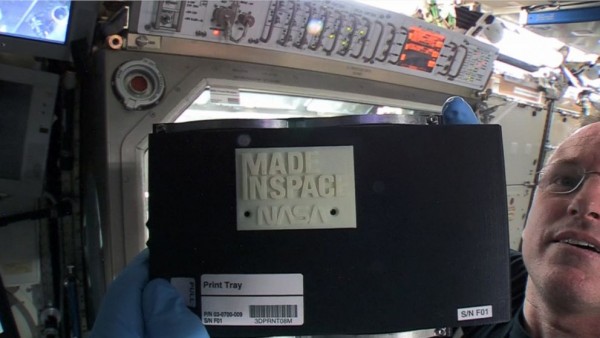ISS' 3D Printer Prints First Item in Space
| Marco Foronda | | Nov 26, 2014 06:56 AM EST |
(Photo : AP Photo/NASA) International Space Station Commander Barry “Butch” Wilmore holds up the first object made in space with additive manufacturing or 3D printing.
The first 3D printer installed at the orbiting International Space Station (ISS) successfully printed its first object Tuesday.
The 3D printer has fabricated its very first item, a faceplate for its own extruder, with the words 'Made in Space" and "NASA" printed on it, CNET reported.
Like Us on Facebook
In September, the National Aeronautics and Space Administration (NASA); U.S. start-up, Made in Space, and the Marshall Space Flight Center built the very first ZeroG 3D Printer that can operate in the weightless environment aboard the ISS.
"It is the first time a 3D printer was ever flown and had the capability to manufacture in the space environment, in microgravity," according to Niki Werkheiser, 3D printing project manager at the Marshall Space Flight Center.
The idea behind the project is "to minimize the shipping of parts and tools from Earth and expedite the space station's self sufficiency."
"The 'First Print' serves to demonstrate the potential of the technology to produce replacement parts on demand if a critical component fails in space," said Jason Dunn, Made in Space Chief Technical Officer.
The ZeroG 3D Printer's first testing phase included printing a variety of test coupons, parts and tools. The items will be sent back to Earth where technicians will analyze features of the objects such as flexibility, tensile strength and torque.
The results of these tests will allow the California-based start-up to improve the second iteration of their microgravity 3D printer, which is scheduled to shipped to the ISS early 2015.
"This project demonstrates the basic fundamentals of useful manufacturing in space. The results of this experiment will serve as a stepping stone for significant future capabilities that will allow for the reduction of spare parts and mass on a spacecraft, which will change exploration mission architectures for the better," said Mike Snyder, Made in Space Director of Research and Development.
TagsISS, 3D-printer, ISS's 3D Printer Released First Creation, NASA, space exploration, ZeroG 3D Printer
©2015 Chinatopix All rights reserved. Do not reproduce without permission
EDITOR'S PICKS
-

Did the Trump administration just announce plans for a trade war with ‘hostile’ China and Russia?
-

US Senate passes Taiwan travel bill slammed by China
-

As Yan Sihong’s family grieves, here are other Chinese students who went missing abroad. Some have never been found
-

Beijing blasts Western critics who ‘smear China’ with the term sharp power
-

China Envoy Seeks to Defuse Tensions With U.S. as a Trade War Brews
-

Singapore's Deputy PM Provides Bitcoin Vote of Confidence Amid China's Blanket Bans
-

China warns investors over risks in overseas virtual currency trading
-

Chinese government most trustworthy: survey
-

Kashima Antlers On Course For Back-To-Back Titles
MOST POPULAR
LATEST NEWS
Zhou Yongkang: China's Former Security Chief Sentenced to Life in Prison

China's former Chief of the Ministry of Public Security, Zhou Yongkang, has been given a life sentence after he was found guilty of abusing his office, bribery and deliberately ... Full Article
TRENDING STORY

China Pork Prices Expected to Stabilize As The Supplies Recover

Elephone P9000 Smartphone is now on Sale on Amazon India

There's a Big Chance Cliffhangers Won't Still Be Resolved When Grey's Anatomy Season 13 Returns

Supreme Court Ruled on Samsung vs Apple Dispute for Patent Infringement

Microsoft Surface Pro 5 Rumors and Release Date: What is the Latest?










